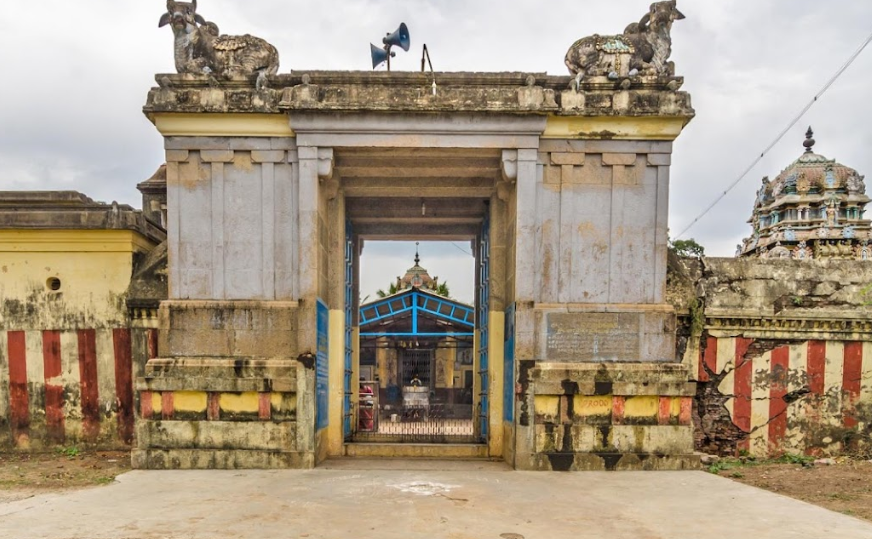There was a village named Kannamangalam, located 2 km north of Thandalacheri, which is now known as Kannandangudi. This place was once praised as the prosperity capital of the Chola kingdom and holds the honour of being the birthplace of Arivattaya Nayanar, a saint from the Velalar-farmers community. Nayanar was known for his immense kindness towards Shiva devotees. His primary mission was to offer Samba rice (a rich variety of rice) with Palak Keerai (spinach) and mango pickles as nivedhana to Lord Shiva every day. Although he contributed to many renovations in the temple, in his view, this daily offering was of utmost importance. His wife wholeheartedly supported him in this service.
Over time, poverty struck their lives, but it did not dissuade them from their devotion. Once a prosperous man, Nayanar became a simple farm labourer, using his wages to continue his offering to the Lord. As the rice from his earnings was devoted to Lord Shiva, Nayanar and his wife survived on just Palak Keerai and, eventually, on mere water. Yet, they were content that they could still provide for the Lord. One day, while carrying the nivedhana to the temple, his wife, weakened from starvation, collapsed. As Nayanar helped her, the basket of offerings spilled and scattered. Distraught over the waste, Nayanar took a sickle (used for cutting paddy) and prepared to end his life. His wife, devastated, held her Mangal Sutra (sacred thread) and prayed to Lord Shiva to save her from widowhood.
At that moment, a divine hand adorned with Rudraksha beads emerged from the ground where the offerings had scattered and stopped Nayanar’s hand, preventing him from harming himself. Lord Shiva, accompanied by Mother Parvathi, appeared before Nayanar and his wife. Nayanar, who had attempted to use a sickle (Aruval in Tamil) to end his life, came to be known as Arivattaya Nayanar.
Sthala Puranam :
A Chola king (believed by some legends to be Kochenga Chola) was once afflicted with leprosy and sought a cure by praying at various temples. One day, Nandi, the bull of Lord Shiva, heard a heavenly voice instructing the king to worship at a temple where Nandi would eat the grass offered by the king. Though the king initially forgot about this divine message, the prophecy came true when he entered this particular temple with a bunch of grass. To his astonishment, the stone idol of Nandi pulled the grass from him and ate it. In time, the king’s leprosy was miraculously cured, and in gratitude, he constructed this temple.
The village of Kannathangudi, located nearby, is the birthplace of Arivattaya Nayanar. This revered saint, born into a family of the Velalar-farmer community, was deeply devoted to Lord Shiva. Along with his wife, he lived a righteous life, offering daily Nivedhana to the Lord, consisting of cooked rice, greens, and pickled mangoes. However, after falling into poverty, Nayanar and his wife struggled to make ends meet. Despite their hardships, they continued their offerings to Lord Shiva.
One day, as Nayanar was carrying the offering, weakened by starvation, he fell, spilling the Nivedhana on the ground. Grieved that he could not present his offering to the Lord, he took a scythe (a sickle) and attempted to cut his own neck in despair. Horrified by his act, his wife prayed fervently to Lord Shiva to save her husband. Moved by their devotion, Lord Shiva and Parvathi appeared on Nandi and granted salvation to both Nayanar and his wife. This miraculous event is depicted in a relief inside the temple. After this incident, Nayanar became known as Arivattaya Nayanar. This temple is considered the place of his salvation, and it holds special significance for local farmers who begin their agricultural activities by offering worship here.
The temple also features a unique depiction of the river Ganga, who is typically seen on Lord Shiva's head but is portrayed here at His feet.
In addition, the temple holds special religious significance related to Lord Vishnu’s Kurma avatar (the tortoise incarnation). According to some Puranas, it is believed that each of Vishnu's Dasavatharam culminates with an act of Lord Shiva. This temple is said to be the place where Lord Shiva subdued the Kurma avatar by removing its tortoise shell and wearing it as an ornament.
As the name of the temple suggests, the presiding deity is called Neelneri Nathar. Following the tradition established by Arivattaya Nayanar, Lord Shiva continues to receive daily offerings of Samba rice, cooked greens, and mango pickle in this temple.
This temple is also honoured by the worship of Patanjali and Vyagrapada, whose Shiva Lingams are enshrined here. Inside the Artha Mandapam, statues of Kochenga Cholan and Arivattaya Nayanar can be found, honouring their devotion.
As one of the 78 mada (elevated) temples built by Kochenga Chola, this temple is of ancient origin, rooted deeply in the heart of the Chola nation. While the original structure may have been built in the early Chola period, it has since become a symbol of divine grace and salvation.
Administration History :
The temple was originally constructed during the Chola period, likely before the 7th century, with Thirugnanasambandar praising its deity. It underwent reconstruction as a stone temple later, with contributions from the Nayakas, Marathas, and the Nattukottai Nagarathars. Significant restoration efforts were initiated by Devakottai Rama Aru Ramanathan Chettiar when the temple fell into disrepair. The maha Kumbhabhishekam was conducted under the guidance of Sri Kanchi Kamakoti Peetadhipathi Jagadguru Sri Jayendra Saraswathi Swamigal on November 7, 1985.
